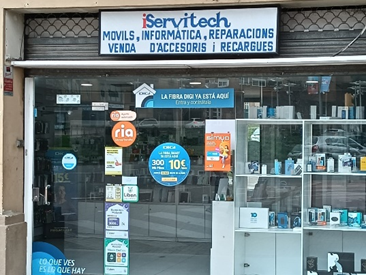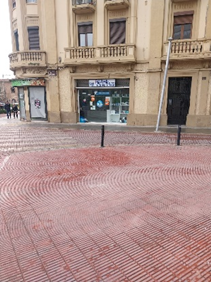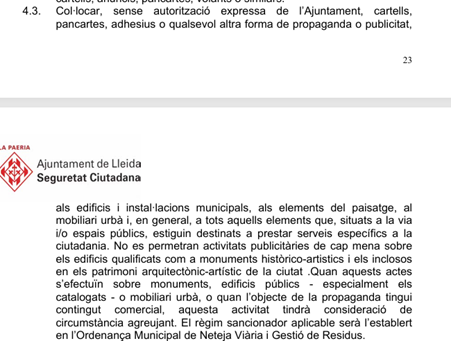iServiTech: The incorporation of advertising in English language in Lleida
iServiTech: The incorporation of
advertising in the English language in Lleida
Localizing
English in Lleida
Sara
Martín and Mireia Bravo
7th
of March of 2025
Degree: English Studies
Subject: English Language in Context
Professor: Maria Sabaté-Dalmau
TABLE OF CONTENTS
1. Introduction
2. Contextualization
3. Methodology
4. Results and Discussion
5. Concluding Thoughts
6. References
Introduction
The Linguistic landscape
token chosen is the establishment devoted to digital devices called
“Iservitech” located in Carrer de Joan Baget, 1. The text typology of the text
is a computer shop sign and, additionally, the posters surrounding the sign at
the top. The establishment is part of the shopping domain, since there is the
option of purchasing technological devices. Furthermore, the main language used
is Catalan, and the background languages are Spanish and English. Finally, in
terms of the alphabet used, it is the Latin one.
Contextualization
Our
token is a shop in Lleida, located in the Carrer de Joan Baget, and at one side
of the Rambla d’Aragó. It is very near the Universitat de Lleida. In general,
it is not a very gentrified area. It is highly migrant populated, and that is
probably why the shop uses several languages, in order to reach more people. It
is a middle-class neighborhood, not especially impoverished. Not many tourists
go in that area, being mostly populated by Lleidatans.
In the
shop image we can see several languages. In the sign, there is “iServiTech”
written, a clear mix between “i” from the English “yo”, and the combination of
two words: Service and Technology. Under the title, we can find the Catalan
language in words like “reparacions” or “informàtica”. However, an orthographic
mistake can be seen. All words there are supposed to be in Catalan, but there
is “movil”, in Spanish, and without the accent. Furthermore, there are stickers
in the windows, with even more languages. In some there is Spanish: “la fibra
digi ya está aquí” or “agente autorizado”. More English too: “money transfer”
“Libon-call/payment”. There is, though, another interesting reference to the
Arabic language: “Ramadan Mubarak” which means “Happy Ramadan”, written with
the Roman alphabet, which strongly references the identity of a whole
culture.
(Figure 1) screenshot of Google Maps the 29/03/2025
(Figure 2) screenshot of Goggle Maps the 29/03/2025
(Figure 3) IDESCAT: https://www.idescat.cat/poblacioestrangera/?b=10&geo=mun:251207
Here,
the different districts of Lleida can be seen, perfectly divided. Firstly, the
totality of the population in the different districts are presented. Secondly,
the specific number of immigrants in each zone, and then, its percentage and
about 1.
Methodology
This
could be an example of the usage of the bottom-up language policy. The
languages were chosen, and the design has been produced by an individual
freely, however, the sign has been created under official regulations.
According to a document that contains the regulations for the use of the Catalan
language in Lleida, all signs displayed to the public must be written in
Catalan. However, often the Catalan language is mixed with the English
language, which allows the owner of the establishment to have some freedom in
terms of the usage of language. Moreover, according to Article 17 (17.2), the
best is for the sign to be written in Catalan, but it could also be written in
Spanish as well. In terms of the bottom-up language policy, these can be the
commercial signs, private notices and community fliers which usually are
accompanied by multilingualism and the addition of several languages. The
top-down language policy consists of public announcements, which are driven by
many rules.
This
establishment is devoted to the repair of technological devices, the sale of
devices, and the phone balance top-up. Due to the vast variety of posters
located in the doors, there are many languages. Besides the many languages,
there is a mistake in the spelling of the word “Movils”. This evidences the
presence of heterography, as it should be written as “Mòbil”, following the
text and context within the sign. The name of the establishment is
“iServitech”, the “i” in front of “Servitech” must be referencing the brand
“Apple” and its product’s name, “iphone” or “ipad”. Furthermore, there is
hegemony of the Catalan language, and the name of the establishment is inspired
by another brand. Moreover, “Servi” could be written in two languages: Spanish
and English, “Servicio” and “Service”. Furthermore, the word “tech”, is a shortened
way to say “technology”. In the sign, the “i” is written in bright red to
highlight the reference to the famous technology brand called “Apple”.
Additionally, the main languages heard when approaching the establishment are
Catalan and Spanish.
(Figure 4) Taken by the authors the 28/03/2025
(Figure 5) Taken by the author the 11/03/2025
(Figure 6) Taken by the authors the 19/03/2025
(Figure 7): Ajuntament de Lleida (2018): http://www.lleidaparticipa.cat/public/197/docs/6c2e2ab8cee8ef11cc82f1e8621d78b5.pdf
(Figure 8): CIDO: normativa local (2014): https://cido.diba.cat/normativa_local/1517903/reglament-per-a-lus-de-la-llengua-catalana-ajuntament-de-lleida
Results
and Discussion
The establishment is located in an area where it is easy to perceive; it does not seem to be that aesthetically pleasing, as the sign is simple, and the text is not that visually intriguing; therefore, the value or function of the token is productive, as it provides financial benefits. The text is written in blue, which symbolizes truthfulness and loyalty; this makes the shop transmit genuineness and security to customers. Red draws attention and radiates a strong energy, this can be seen in the use of red in the letter “i”, which emphasizes the text and draws attention from potential clients. On the other hand, multimodality is highly present since there are several images attached to the door of the computer shop. The posters and print advertisements attached to the doors encourage individuals to enter and get the service offered by the computer shop. In terms of the historical value, the shop is located in a building where there is no remarkable historical value. Furthermore, the shop does not count with a vast amount of clients. It is rarely crowded and does not seem to have many visitors on the daily. Many individuals wrote their own opinion on the service offered by the establishment, and there were mixed opinions about the computer shop. In Google Maps, within the review section, the shop counts with 3.3/5 stars, which is significantly positive.
The usage of the English language has a proper impact in the city of Lleida; there are many establishments that choose to use English in order to have a bigger impact. However, the establishment does not appear to have a significant repercussion in terms of the Englishization. Additionally, there is not an exclusion of minority, majority languages, and lingua francas since it has many signs attached to the door that include many languages. In terms of the positioning concerning the exclusion of minority and majority languages and lingua francas, it is extremely important to bear in mind that all languages should be appreciated and encouraged to use. Having the chance to be able to appreciate and enjoy many languages is not only enriching for everyone, but also allows us to communicate with each other and understand the cultural significance of each language.
The Landscape has social value because this establishment is located near a university and surrounded by numerous office buildings.
(Figure 9) Taken by the authors the 28/02/2025
Concluding
Thoughts
After
doing this project, we can acknowledge several matters. The first one, that we
had the opportunity to see in real life, what was taught in the theoretical
classes. This way, it is easily understandable the contents explained, since it
has been demonstrated in real life. And not only that, but also in our
environment, and in a context that is deeply linked with our personal lives.
After doing this project, it is impossible not to pay attention to these
details as you walk on the street.
Due to
the extended investigation and knowledge acquired in both this subject and
project, now an analysis of the sociocultural situation is possible, not only
in the specific space that we did in this project, but in all aspects of our
life. The shop we selected included more than one language, as to demonstrate
the huge influences of those languages in that specific neighborhood. And we,
not only as students or youngsters but also as observers, are capable of seeing
and analyzing it, in order to study how it affects society and in language
development. Only thanks to that, we will be able to change any potential
dangers or difficulties related to what has been explained in this project,
such as language dangers, immigrants not being accepted, among others.
Furthermore,
technologies were used to make this investigation possible, giving them a new
opportunity to be useful for the information gathering, in order to understand
linguistic landscapes better, in relation with the social connections that we
are working with in this city. We made pictures with mobile phones, and created
the web and Word document with computers.
References
Ajuntament
de Lleida. (2014). Reglament per a l’ús de la llengua catalana. Bulletí
Oficial de la Província de Lleida. Retrived from https://bop.diputaciolleida.cat
Color Meanings. (n. d.). Color Meanings – Discover
the Power and Symbolism Behind Every Hue. https://www.color-meanings.com/#blue
Glossari
de paisatge | Observatori del Paisatge. (n. d.). https://www.catpaisatge.net/en/landscape-resources/landscape-glossary
Idescat.
Població estrangera a 1 de gener. Per
districtes. Lleida. (n. d.). https://www.idescat.cat/poblacioestrangera/?b=10&geo=mun:251207
I Servitech Movils Informatica · Carrer Joan Baget,
25003 Lleida, Spain. (n.d.). I Servitech Movils
Informatica · Carrer Joan Baget, 25003 Lleida, Spain. https://www.google.es/maps/place/I+Servitech+Movils+Informatica/@41.6159373,0.6103531,2826m/data=!3m2!1e3!4b1!4m6!3m5!1s0x12a6e06b344719eb:0xb64ab738516ca81c!8m2!3d41.6159378!4d0.6206314!16s%2Fg%2F11cmfv_qt_!5m1!1e2?entry=ttu&g_ep=EgoyMDI1MDMxOS4yIKXMDSoASAFQAw%3D%3D
Prego-Vázquez,
G. i Zas Varela, L. (2018). Paisaje lingüístico: Un recurso TIC-TAC-TEP para el
aula. Lingue Linguaggi 25: 277-295
Reglament per a l’ús de la llengua catalana | Ajuntament de Lleida | Normativa local | Cercador d’Informació i Documentació Oficials (CIDO) - Diputació de Barcelona. (n. d.). Cercador D’Informació I Documentació Oficials (CIDO) - Diputació de Barcelona. https://cido.diba.cat/normativa_local/1517903/reglament-per-a-lus-de-la-llengua-catalana-ajuntament-de-lleida
Sabaté-Dalmau, M. (2025). English language in context: Unit 1 sociolinguistics. University of Lleida. Hand-out_and_Ppt_Unit_1_19_20.pdf










Comments
Post a Comment